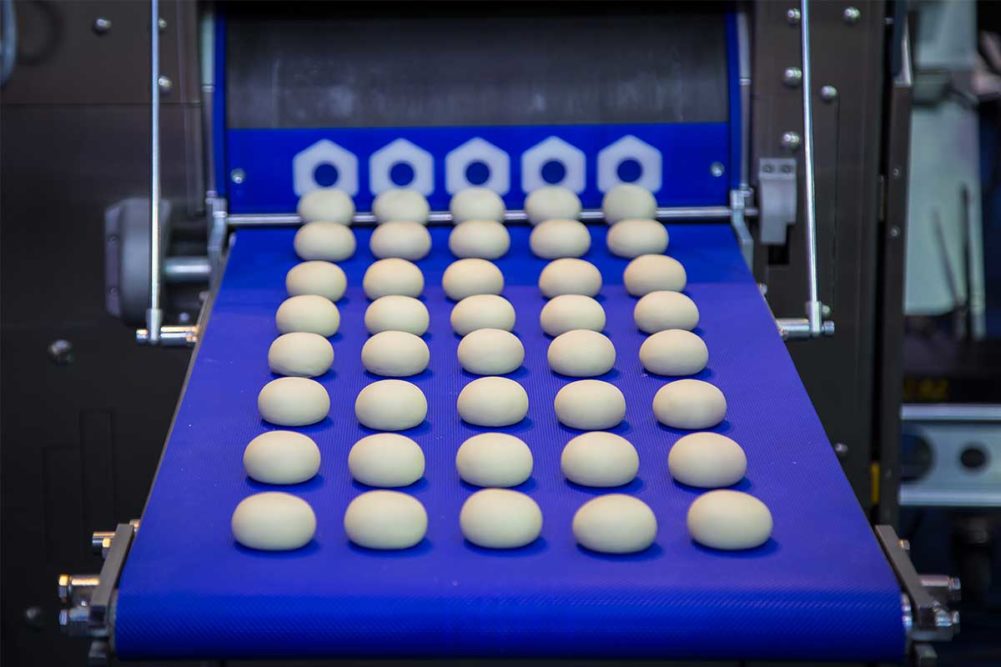Commercial bakers must juggle a variety of needs when it comes to their dividers. They require equipment that can handle a high level of throughput and keep up with demand while at the same time maintaining a quality product that withstands processing. Versatility is another need for bakers making a variety of products, as is accuracy, especially as ingredient costs continue to rise.
“I would say the biggest change over the past decade is bakers looking for alternate ways to divide dough because the standard that’s been there for 50 to 60 years doesn’t always address the new challenges for speed or the quality of the dough,” explained Ken Hagedorn, vice president, bakery sector, Handtmann.
The competition among suppliers to meet these needs has raised the bar on all equipment, noted John McIsaac, vice president of strategic business development at Reiser. Servo technology, for example, has increased accuracy and tightened dough scaling, he said. Dividers today can also better sense pressure applied to the dough and reduce damage, allowing bakers to produce a greater number of products. And all of this is being done at faster speeds than ever before.
Optimizing divider speed and versatility are top priorities for many bakers, but it’s often difficult to accomplish one of these without making sacrifices with the other. This balancing act requires bakers to carefully consider their specific production needs when selecting their next divider.
“High-speed dividers bring reliability to the scaling weights; with consistent hydration, there are less variables to consider and the machine can be dialed in to run at faster speeds with greater accuracy,” said Nate McDermott, director of customer service and technical sales of WP Bakery Group USA. “Normally, they are designed for a narrow weight range/capacity. With a more flexible divider, you can process a wider range of hydrations and weights, but the accuracy can vary.”
Jerry Murphy, vice president of sales, Gemini Bakery Equipment, observed the tradeoff between speed and flexibility will come down to the amount of punishment a dough can tolerate while still maintaining a quality product.
“It is all about dough rheology, dough consistency and finished product characteristics and quality,” he emphasized.
Bakers must also decide between an extrusion or volumetric divider for their line, both of which come with their own benefits and potential downsides.
Hagedorn noted that extrusion dividers, with precise control of servo motors, can typically run faster, and more accurately, than traditional volumetric dividers. However, Murphy pointed out that these greater speeds can add more punishment to the dough.
“Between those two options, you always want to use a volumetric divider for any products that have bulk fermentation prior to dividing, more delicate doughs with high absorption rates or those that require a fine dough structure,” McDermott said.
Bruce Campbell, vice president of dough processing technologies, AMF Bakery Systems, observed that the number of changeovers is the main factor in choosing between a volumetric or extrusion divider.
“If the bakery has more than 20 changeovers a day requiring a different type of dough, then a volumetric divider may offer more efficiency since the dough loss is less than a twin-screw extrusion divider,” he said. “However, the efficiency of the extrusion divider still may offer a net dough savings.”
The latest dividing technology, however, is letting bakers enjoy the best of both worlds when it comes to speed and versatility.
Reiser, for example, offers its HPE and HPR series dividers for high-speed production, handling applications ranging from pizza dough, bread and rolls to multi-lane tortilla dividing.
“Our ability to fill our double screws with a controllable amount of mechanical action and vacuum can produce a variety of product crumb structures,” McIsaac explained. “Our systems process dough quickly, and our speeds are unmatched, but we are able to handle a range of doughs that previously could only be done with pocket dividers. We like to think of the Vemag as a continuous pocket divider — without the oil, doubles and time-consuming rebuilds associated with pocket dividers.”
Similarly, the vane pump system of Handtmann dividers can handle a wide range of products, limiting stress on the dough and ensuring accuracy.
“If your feeding system isn’t doing much damage, it opens up a spectrum of products that you can do,” Hagedorn said.
Murphy noted that Gemini offers several features that increase the flexibility of its roll line and bread dividers. Its Transmission Position Adjustable (TPA) dividers are made with a quick-adjust rounding drum height relative to the dividing head.
“This greatly expands the weight and size range of dough balls that can be produced on one machine from 1.5 oz to 18 oz with the use of a wide range of interchangeable dividing heads and drums available,” he explained.
He added that maximizing divider flexibility will also come down to being more flexible with product recipes.
“Sometimes this means changing the dough temperature if it’s too hot, reducing some water or adding in bases or stabilizers,” he said.
Rheon USA offers stress-free dough dividers that can handle a variety of recipes and dough types, noted John Giacoio, vice president of sales, including traditional rye and pumpernickel dough to highly hydrated doughs like ciabatta.
“This allows for a great deal of flexibility in the possible products that can be made,” he said.
This article is an excerpt from the December 2023 issue of Baking & Snack. To read the entire feature on Dividing, click here.





